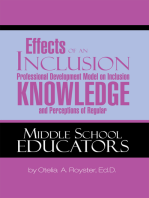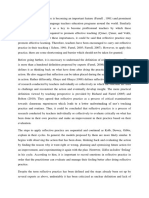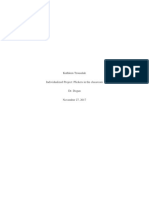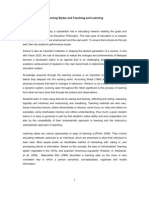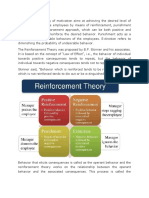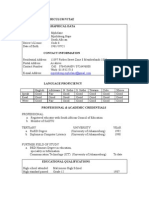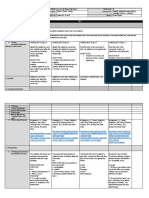ASTENJournal-V2-I1-Self-efficacy and Job
ASTENJournal-V2-I1-Self-efficacy and Job
Uploaded by
Nu Nu NyuntCopyright:
Available Formats
ASTENJournal-V2-I1-Self-efficacy and Job
ASTENJournal-V2-I1-Self-efficacy and Job
Uploaded by
Nu Nu NyuntOriginal Description:
Copyright
Available Formats
Share this document
Did you find this document useful?
Is this content inappropriate?
Copyright:
Available Formats
ASTENJournal-V2-I1-Self-efficacy and Job
ASTENJournal-V2-I1-Self-efficacy and Job
Uploaded by
Nu Nu NyuntCopyright:
Available Formats
An Exploratory Study of Self-efficacy and Job
Satisfaction of Secondary School Teachers
Nu Nu Nyunt
Department of Educational Psychology
Yangon University of Education
nyuntnn@gmail.com
Thida Aung
Basic Education High School No.3, Tamwe, Yangon
sakura.dawei1985@gmail.com
Abstract
The main purpose of this study was to investigate the factors affecting the self-efficacy of secondary
school teachers and their satisfaction to the teaching profession. A total of 530 teachers from eight
selected Basic Education High Schools from Yangon Region and six basic Education High Schools
from Tanintharyi Region participated in this study. This study employed the questionnaire survey
method using the Teacher Self-Efficacy Scale and Teacher Job Satisfaction Survey. Regarding the
teachers’ self-efficacy, significant difference was found on efficacy to enlist parental involvement
subscale by age. Moreover, there were significant differences on efficacy to influence decision making
and efficacy to enlist parental involvement subscales by teaching experience. Concerning the teachers’
job satisfaction, significant difference was found by age. In addition, there was significant difference on
the whole test of job satisfaction among different teaching experience groups. Relating to designation,
there was a significant difference on job satisfaction. The significant difference was found to be on job
satisfaction by region. The result evidently showed that teachers’ self-efficacy was positively related
to job satisfaction. The result of simple linear regression analysis revealed that self-efficacy may
be considered as a predictor of job satisfaction. The teachers who have high self-efficacy would be
satisfied with their jobs. Thus, the policy-makers should consider to design and apply appropriate
policies to create professional development programs to increase teachers’ self-efficacy.
Keywords:
self-efficacy, job satisfaction
Introduction or threats and opportunities (Bandura, 1997). In
addition, teachers’ self-efficacy can make instructional
Teacher’s efficacy is a type of self-efficacy, strategies more meaningful by engaging all students
which impacts behavior by influencing goals, outcome in learning activities. Teachers’ self-efficacy is
expectations, affective states, perceptions of obstacles considered to be one of the most important factors
Volume 2 ● Issue No.1 AsTEN Journal of Teacher Education 2017 │ 1
effecting teachers’ satisfaction to teaching professions Literature Review
and includes important implication in education.
Teachers with high self-efficacy can skillfully plan Teacher’s Self-efficacy
and organize new teaching strategies, which could
be implemented to their students to have clear goals Dellinger, Bobbett, Olivier & Ellett (2008)
with high ambition. Teachers with greater self- described teacher efficacy as a teacher’s individual
efficacy have greater passion for teaching and achieve beliefs in his/her capabilities to perform specific
successful classroom management that they would like teaching task or a specified level of quality in a specific
to continue in the teaching profession (Eberle, 2011). situation. Strong self-efficacy also promotes a strong
Teachers’ self-efficacy plays a vital role in affecting sense of commitment to the profession and increases
and sustaining their commitment to school and their collaboration with colleagues and parents (Tschannen-
job satisfaction. In schools, teachers’ job satisfaction Moran & Hoy, 2007).Teachers’ self-efficacy not only
is extremely important to make teaching and learning increases job satisfaction but also influences teachers’
processes more effective. Teachers who are not teaching behaviors and thereby has an effect on the
pleased with their jobs will not be able to make their motivation and achievement of students (Skaalvik &
pupils attain learning. It is likely that job satisfaction Skaalvik, 2007).
accompanies teachers’ self-efficacy and contributes
to sustain their efforts towards pursuing children’s Teacher’s Job Satisfaction
optimal scholastic attainment (Caprara, Barbaranelli,
Borgogni, & Stecta, 2003). Job satisfaction stems from the nature
of the work performed, such as achievement
Teachers’ job satisfaction is of great importance and recognition related to the work. Thus, job
to the education process because teachers who leave satisfaction exists when intrinsic feelings of
the profession are often dissatisfied with their chosen happiness promote job satisfaction in the teacher.
career and exhibit low levels of teacher self-efficacy In contrast, job dissatisfaction is derived from
and job satisfaction (Blackburn & Shane, 2008) In the extrinsic circumstances in which the work
fact, the Myanmar government has been devoted to is conducted. It is impacted through salaries,
ensuring an increase in accessibility and improving interpersonal relationships, resources and working
the quality of education at all levels including the conditions. Addressing and reducing the factors
basic education so that it suits the future needs related to job dissatisfaction will not necessarily
of the society and the demands of globalization. increase a person’s job satisfaction, therefore, they
Consequently, the government continually makes are inversely related to each other (Ngimbudzi,
great efforts in cooperation with other stakeholders for 2009).If the factors that generally cause job
the development of Myanmar education system. Such satisfaction are unpleasant, the outcome ends up
efforts will be futile if teachers’ self-efficacy and job being the reverse: job dissatisfaction (Salifu &
satisfaction are not addressed by school administrators. Agbenyega, 2013). Albanese (2008) stated that job
Myanmar teachers even experienced low salary dissatisfaction associated with; monthly salaries,
payments, lack of proper housing, inadequate teaching incapable and unsupportive administrators and of
facilities, and limited opportunities for professional collegial relationship with co-workers. Incapable
development that may influence their self-efficacies. leaders and salary were key factors that influenced
Educational leaders, policy makers and other key job dissatisfaction.
stakeholders in the education sector need to have a
clear understanding of the factors that could motivate Teacher’s Job Satisfaction and Self-efficacy
teachers so that school performance and teaching
effectiveness are to be improved. Therefore, studying Skaalvik and Skaalvik (2007) found that
the self-efficacy and job satisfaction of secondary teacher’s job satisfaction and self-efficacy have
school teachers is necessary. a strong positive relationship among primary and
secondary school teachers. Their research supported
2 │ AsTEN Journal of Teacher Education 2017 Volume 2 ● Issue No.1
that teacher’s autonomy, good interpersonal relations Methodology
between teachers and parents and high time pressure
were the most important factors that influence Sample of the Study
teachers’ job satisfaction. The study conducted
by Akomolafe and Ogunmakin (2014) revealed a A total of 530 teachers were selected by random
significant relationship between self-efficacy and job sampling technique from fourteen Basic Education
satisfaction. They found that self-efficacy ultimately High Schools from Yangon Region and Tanintharyi
determines how an individual behaves, thinks and Region. In Yangon Region, about 70 teachers from
becomes motivated to be involved in a particular two schools in each district and the total number of
task. For this reason, individuals with high self- teachers were 280 teachers. In Tanintharyi Region, the
efficacy tend to behave more positively, think more 250 teachers were included: 33 teachers from B.E.H.S,
creatively which also interacts with motivation. Kanbauk; 32 teachers from B.E.H.S, Yephyu; 32
Consequently, such teachers are relatively more teachers from B.E.H.S, Launglon; 36 teachers from
satisfied with their jobs. Another possible reason B.E.H.S, Thayetchaung; 62 teachers from B.E.H.S(1)
for this finding is that individuals with high level Dawei and 55 teachers from B.E.H.S(3) Dawei.
of self-efficacy have the ability to effectively handle
various tasks, obligations and challenges related to Instrumentation
their professional role. Therefore, it is not surprising
that s significant positive relationship was found The teacher self-efficacy scale (TSES)
between self-efficacy and job satisfaction among questionnaire is based on the work of (Bandura, 1997).
teachers. The instrument consisted of two main parts. The first
part consisted of demographic or personal factors,
Purpose of the Study which included such aspects as: age, designation,
teaching experience, district and region. The second
The purpose of this research is to investigate part of the instrument consisted of 30 items and each
the factors effecting the self-efficacy of secondary item was rated based on a five-point Likert-Scale (i.e.
school teachers profession from selected schools in 1=Nothing, 2=Very Little, 3=Some Influence, 4=Quite
Yangon Region and Tanintharyi Region and their a Bit, and 5=A Great Deal). The 30 items are organized
satisfaction to the teaching profession Furthermore, into seven categories; Efficacy to Influence Decision
to examine the relationship, if any, between their self- Making, Efficacy to Influence School Resources,
efficacy and their job satisfaction. Specifically, the Instructional Self-Efficacy, Disciplinary Self-Efficacy,
study sought answers to the following questions: Efficacy to Enlist Community Involvement and
Efficacy to Create a Positive School Climate.
1. Is there any difference in self-efficacy
and job satisfaction of secondary school The teacher job satisfaction survey (TJSS)
teachers by age, teaching experience, questionnaire is based on the work of (Ngimbudzi,
designation, marital status and region? 2009) which consisted of 35 items and each item was
rated based on a five-point Likert-Scale (i.e. 1=Strongly
2. Is there any relationship between Disagree, 2=Disagree, 3=Neutral, 4=Agree, and
secondary school teachers’ self-efficacy 5=Strongly Agree). Teacher Job Satisfaction can be
and their satisfaction to teaching classified into five factors such as Job Characteristics,
profession? Social Benefits, and Meaningfulness of the Job,
Supportive Administration and Intention to remain
in the Job. Prior to the actual data collection, pilot
study was done in the first week of December, 2016.
The internal consistency (Cronbach α) of the whole
inventory for TSES and TJSS were 0.938 and 0.909,
respectively. Thus, computation of Cronbach alpha
Volume 2 ● Issue No.1 AsTEN Journal of Teacher Education 2017 │ 3
showed that the mentioned two instruments had high school teachers from No.(2) Basic Education High
reliability to measure self-efficacy and job satisfaction School, Tarmwe to check whether the wording
of teachers. of statements was appropriate and relevant to the
teachers or not. Then, the final version of Teacher
Research Design, Data Collection and Analysis Self-Efficacy Scale (TSES) Questionnaire consist
of 30 items and Teacher Job Satisfaction Survey
The design of this study is cross sectional (TJSS) Questionnaire consists of 35 items. Before the
in nature. Quantitative approach was applied. data collection process, consent forms were sent in
Descriptive survey method was used to examine advance. Participant teachers were administered by
the factors affecting the self-efficacy of secondary paper and pencil format of two instruments at the first
school teachers and their satisfaction to the teaching week of January in 2017. Data entry process was done
profession. using a statistical package for social science software
version 20. The quantitative data were analyzed
Firstly, Teacher Self-Efficacy Scale (TSES) using independent sample t-test, one way ANOVA
Questionnaire and Teacher Job Satisfaction Survey (Analysis of Variance), Pearson Product-moment
Questionnaire (TJSS) were adaptedto Myanmar correlation and simple linear regression analysis.
context. Then, by 14 experts in the field of education,
educational psychology and test and measurement Results and Discussions
from Yangon University of Education conducted
for face and content validity. Prior to the actual data Using the Teacher Self-Efficacy Scale (TSES)
collection, pilot study was done in the first week and Teacher Job Satisfaction Survey (TJSS), the
of December in 2017 with sample of 20 secondary teachers’ self-efficacy and job satisfaction of 530
Table 1. Mean Comparison of Teachers’ Self-Efficacy by Age, Teaching
Experience, Marital Status, Designation and Region
Variables Efficacy to Efficacy to Instructional Disciplinary Efficacy to Efficacy to Enlist Efficacy to
Influence Influence School Self-efficacy Self-efficacy Enlist Parental Community Create a Positive
Decision Making Resources Involvement Involvement School Climate
Age
20-30 years 5.7 3.3 30.43 11.40 9.81 11.47 27
31-40 years 5.79 3.29 30.47 11.39 10.05 12.01 27.48
41-50 years 6.16 3.26 31.20 11.33 10.44 12.34 28.27
51-60 years 6.09 3.37 30.96 11.27 10.43 12.05 28.29
F 2.19 0.79 1.07 0.21 3.42* 1.86 2.49
P 0.08 0.49 0.36 0.89 0.02 0.134 0.06
Teaching Experience
1-10 years 5.68 3.30 30.40 11.42 9.99 11.63 27.17
11-20 years 5.85 3.28 30.76 11.37 10.22 12.19 27.83
21-30 years 6.28 3.29 31.08 11.27 10.29 12.06 28.03
31-40 years 6.02 3.39 30.99 11.30 10.56 12.27 28.64
F 3.83* 0.71 0.72 0.25 2.46 1.65 2.64*
P 0.01 0.55 0.54 0.86 0.06 0.18 0.05
Marital Status
Single 6.07 3.33 30.75 11.32 10.26 12.06 27.85
Married 5.93 3.29 30.98 11.34 10.30 12.09 28.12
t 1.06 0.72 -0.67 -0.18 -0.29 -0.15 -0.81
p 0.39 0.25 0.26 0.97 0.75 0.95 0.91
Designation
Junior Teachers 6.06 3.33 31.06 11.40 10.39 12.17 28.33
Senior Teachers 5.93 3.29 30.62 11.25 10.16 11.96 27.56
t 1.002 0.54 1.33 1.15 1.66 1.09* 2.28
p 0.16 0.96 0.18 0.66 0.69 0.04 0.76
Region
Region (1) 5.84 3.34 30.49 11.34 10.34 11.67 27.98
Region(2) 6.19 3.28 31.26 11.32 10.22 12.52 27.96
t -2.68 0.88 -2.33 0.17 0.87 4.47** 0.04
p 0.08 0.71 0.55 0.49 0.59 0.003 0.31
*The mean difference is significant at the 0.05 level.
**The mean difference is significant at the 0.01 level.
4 │ AsTEN Journal of Teacher Education 2017 Volume 2 ● Issue No.1
teachers from the selected schools in Yangon Region significant difference was found to be only on efficacy
and Tanintharyi Region were determined. Moreover, to enlist community involvement subscale.
the other factors effecting the teachers’ self-efficacy
and job satisfaction such as age, teaching experience, The mean score of self-efficacy by region were
marital status, designation and region were also also shown in Table 1. Depending on the results of
explored. the table, it can be interpreted that the mean score
of Region (2) was higher than that of Region (1).
Comparing Teachers’ Self-Efficacy by Age, Independent sample t-test confirmed that there was no
Teaching Experience, Marital Status, Designation significant difference on overall test of self-efficacy by
and Region region. It can reasonably be said that teachers’ self-
efficacy does not depend on region. Among the seven
Table (1) shows the difference in the mean
subscales, there was significant difference on efficacy
score of self-efficacy by age. The mean score of
to enlist community involvement.
the (41-50) year age group was slightly higher than
other age groups.
Comparing Teachers’ Job Satisfaction by Age,
Teaching Experience, Marital Status, Designation
Table (1) shows the differences in mean score of and Region
self-efficacy by teaching experience.. The mean score
of the (31-40) years teaching experience group was Regarding the job satisfaction, the mean score
slightly higher than other teaching experience groups, of the 41-50 year age group was the highest among
statistically found to be a significant difference through other age groups. It can be said that the 41-50 year
ANOVA. However, there was no significant difference age group teachers were the best in satisfaction upon
on overall self-efficacy. Among the subscales, there their jobs. In addition, the mean score of the 51-60
were significant differences on efficacy to influence year age group was the second highest among other
decision making as well as efficacy to enlist parental age groups. Comparison of the aforementioned
involvement. results shows that there was significant difference on
overall job satisfaction by age. In addition, there were
To obtain more detailed information, Post-hoc significant differences on three out of five subscales
test was executed by Tukey HSD method. Concerning such as social benefits, meaningfulness of the job and
the self-efficacy to influence decision making intention to remain in the job by age.
factor, the mean score of the (21-30) years teaching
experience group was significantly higher than that In order to confirm the specific difference of
of 1-10 years teaching experience group. Moreover, teachers’ job satisfaction by age, post-hoc test was
the mean score of 31-40 years teaching experience executed by Tukey HSD method. The mean score of
group was significantly higher than that of 1-10 years 51-60 year age group was significantly higher than
teaching experience group in efficacy to enlist parental that of other age groups in meaningfulness of the job
involvement and efficacy to create a positive school and intention to remain in the job subscales. It may
climate factors. It may be assumed that the longer the reasonably be said that the 51-60 years age group
teaching experience, the higher the self-efficacy. teachers are satisfied more on their job regarding the
above two factors. On the other hand, the higher the
Furthermore, the mean and standard deviations teachers’ age, the higher the level of job satisfaction.
of self-efficacy for both junior teachers and senior
teachers were shown. The results revealed that the The results revealed that the mean score of 21-
mean score of junior teachers was greater than that of 30 years teaching experience group was the highest
senior teachers. Independent sample t-test confirmed on overall job satisfaction. Concerning the job
that, there was no significant difference on the overall characteristics and social benefits, the mean score of
self-efficacy by designation. It can reasonably be 21-30 years teaching experience group was greater
said that teachers’ self-efficacy does not depend than that of other theteaching experience groups.
on designation. Among the seven subscales, the Regarding the intention to remain in the job, the mean
Volume 2 ● Issue No.1 AsTEN Journal of Teacher Education 2017 │ 5
Table 2. Mean Comparison of Teachers’ Self-Efficacy by Age, Teaching
Experience, Marital Status, Designation and Region
Variables Job Characteristics Social Benefits Meaningfulness Supportive Intention to Remain
of the Job Administration in the Job
Age
20-30 years 43.98 39.34 19.23 10.98 14.94
31-40 years 44.87 38.95 19.61 11.08 14.89
41-50 years 46.20 40.04 19.92 11.24 15.36
51-60 years 45.57 39.98 20.12 11.00 15.71
F 2.33 2.65* 3.11* 0.73 3.36*
P 0.07 0.05 0.03 0.53 0.02
Teaching Experience
1-10 years 43.26 38.84 19.14 11.03 14.78
11-20 years 45.85 39.48 19.78 11.05 15.04
21-30 years 46.75 40.16 20.09 11.31 15.65
31-40 years 44.70 39.88 20.15 10.85 15.67
F 8.65*** 2.75* 5.23*** 2.18 3.89**
P 0.00 0.04 0.001 0.09 0.009
Marital Status
Single 45.67 39.43 19.74 11.10 15.43
Married 45.16 39.99 20.00 11.08 15.25
t 1.01 -1.71 -1.42 0.13 0.82
p 0.82 0.80 0.79 0.09 0.47
Designation
Junior Teachers 46.16 39.93 20.14 11.13 15.47
Senior Teachers 44.60 39.41 19.54 11.04 15.20
t 3.07*** 1.58 3.26*** 0.68 1.22
p 0.001 0.42 0.001 0.78 0.38
Region
Region (1) 44.63 39.43 19.74 10.98 15.29
Region(2) 46.32 39.08 19.99 11.21 15.40
t 3.43*** -1.72** -1.37** -1.71 -0.53
p 0.000 0.003 0.009 0.71 0.43
*The mean difference is significant at the 0.05 level.
**The mean difference is significant at the 0.01 level.
***The mean difference is significant at 0.001 level.
score of 31-40 years teaching experience group was 40 years teaching experience groups. Regarding the
greater than that of other teaching experience groups social benefits, the mean score of 21-30 years teaching
(See Table 2). According to the ANOVA results, there experience group was significantly higher than that
was significant difference on overall job satisfaction by of 1-10 years teaching experience group. Relating
teaching experience. Moreover, there were significant the meaningfulness of the job, the mean score of 21-
differences on the other four subscales except 30 and 31-40 years teaching experience groups were
supportive administration. This finding is inconsistent significantly higher than that of 1-10 years teaching
with the finding of Crossman and Harris (2006) who experience group.
found that teaching experience did not contribute to
any significant differences on job satisfaction among According to Table 2, the mean score of junior
secondary school teachers in the United Kingdom. teachers was greater than that of senior teachers on job
satisfaction. It may be said that junior teachers were
To examine the significant difference of more satisfied upon their jobs than senior teachers. It
teachers’ job satisfaction by teaching experience, may be due to the fact that senior teachers take more
post-hoc test was executed by Tukey HSD method. workloads and much responsibility to get high pass
The results showed that the mean score of the 1-10 rate of matriculation exam results for their respective
years teaching experience group was the lowest on subjects than junior teachers. So, senior teachers did
overall job satisfaction. It may be concluded that the not satisfy their jobs as junior teachers. According
less teaching experienced teachers show the lower to the independent sample t-test results, there was
degree of satisfaction on their jobs. Concerning the significant difference on overall job satisfaction
job characteristics, the mean score of 11-20 years by designation. In addition, there were significant
and 21-30 years teaching experience groups were differences on job characteristics and meaningfulness
significantly higher than that of 1-10years and 31- of the job subscales.
6 │ AsTEN Journal of Teacher Education 2017 Volume 2 ● Issue No.1
The results revealed that the mean score of Accordingly, the mentioned regression equation,
job satisfaction of teachers from Region (2) was show that a one point increase in the value of
greater than that of Region (1). In order to confirm self-efficacy is expected to be accompanied by an
the difference of teachers’ job satisfaction by region, increase of 0.529 points on job satisfaction. This
independent sample t-test was calculated. The results finding is consistent with the study of Caprara,
showed that there was significant difference on the Barbaranelli, Steca, and Malone, (2006). They
overall job satisfaction by region. It may be assumed found that teacher self-efficacy beliefs influenced
that teachers from Region (2) are more satisfied with job satisfaction. In another similar research, Buluç
their jobs than teachers from Region (1). Among and Demir , (2015) found that teachers’ self-efficacy
the subscales, significant differences were found perceptions significantly predicted job satisfaction.
to be on job characteristics, social benefits and In similar studies, teacher efficacy was found to be
meaningfulness of the job. effective on job satisfaction (Klassen & Chiu 2010).
Result shows that there is a positive significant Conclusion
correlation between teachers’ self-efficacy and their
job satisfaction. This finding is consistent with The main purpose of this study is to investigate
previous research conducted by Telef (2011). Telef the relationship between secondary school teachers’
(2011) found that self-efficacy has statistically self-efficacy and job satisfaction. A total of 530
significant positive relationship with teachers’ job teachers from eight Basic Education High Schools in
satisfaction. It may be concluded that the more Yangon Region and six Basic Education High Schools
the teachers have high self-efficacy, the greater in Tanintharyi Region participated.
satisfaction they feel. On the other hand, the lower
self-efficacy the teachers have, the less satisfaction Regarding the teachers’ self-efficacy, it was
they feel. It may be due to the fact that individuals found that there were no significant differences on
with high levels of self-efficacy have the ability to overall self-efficacy by age, teaching experience,
effectively handle various tasks, obligations and marital status, designation and region. However,
challenges related to their professional role. Thus, it significant difference was found on efficacy to enlist
is not surprising that a significant positive relationship parental involvement subscale by age. Moreover, there
was found between self-efficacy and job satisfaction were significant differences on efficacy to influence
among teachers. decision making and efficacy to enlist parental
involvement subscales by teaching experience.
Regression Analysis for the Prediction of Job
Satisfaction Concerning the teachers’ job satisfaction,
significant difference was found by age and the mean
A simple linear regression analysis was score of (41-50) year age group was the highest. In
calculated to identify the model for predicting job addition, there was significant difference on overall
satisfaction. Regression analysis revealed that the job satisfaction by teaching experience and the mean
model significantly explained job satisfaction, score of (21-30) years teaching experience group
F= 197.294, p< 0.000. R2 for the model was 0.272 was the highest. However, there was no significant
and adjusted R2 was 0.271.Result show that, self- difference on job satisfaction by marital status.
efficacy contributed 27.1% of the variance to job
satisfaction. By applying simple linear regression Relating to the designation, it was observed that
analysis presented above, the resultant model for there was significant difference on job satisfaction.
job satisfaction can be defined as in the following The mean score of junior teachers was greater than
equation concerned with self-efficacy. that of senior teachers. The significant difference was
found to be on job satisfaction by region. The mean
Job Satisfaction=77.584+0.529SE score of Region (2) was higher than that of Region
(1). The result evidently showed that teachers’ self-
efficacy was positively related with job satisfaction.
Volume 2 ● Issue No.1 AsTEN Journal of Teacher Education 2017 │ 7
In addition, teachers’ self-efficacy was the strong Bandura, A. (1977). Self-efficacy: Toward a unifying
predictor of their job satisfaction. So, it may be theory of behavioral change. Psychological
interpreted that the higher the teachers’ self-efficacy, Review, 84, 191-215.
the more satisfaction the teachers feel in their job.
Bandura, A. (1997). Self-efficacy: The exercise of
Recommendations control. New York, NY: Freeman.
Limitations of the study include restriction to Bishay, A. (1996). Teacher motivation and job
Yangon Region and Tanintharyi Region. In this study, satisfaction: a study employing the
the sample teachers were selected only from above experience sampling method. Journal of
mentioned regions. Because of the economy of time, Undergraduate Science, 3, 147-154.
teachers from other regions and states were excluded.
In addition, the difference between rural and urban Blackburn, J. Joey; Robinson, J. Shane (2008).
areas was not investigated in this study. Moreover, this Assessing teacher self-efficacy and job
study was carried out by using quantitative research satisfaction of early career agriculture
design due to the economy of time. teachers in Kentucky.. Journal of Agricultural
Education, v49 n3 p1-11 2008.
In this study, the research tried to investigate into
the self-efficacy and job satisfaction of the secondary Bobbett, Olivier & Ellett (2008).Measuring Teachers’
school teachers. The sample of the teachers was Self-Efficacy Beliefs: Development and Use
chosen only from Yangon Region and Tanintharyi of the TEBS-Self. Self-teaching and Teacher
Region. If possible, future research should be carried Education, 24, 751-766.
out by selecting teachers from other regions and states
so that sample might be representative. In addition, Bogler, R. (2001). The influence of leadership style
future research should investigate the difference on teacher job satisfaction. Educational
between rural and urban areas. Moreover, future Administration Quarterly, 37(5), 662-683.
research should be conducted by using qualitative
approach in order to get more detail information about Buluç, B. & Demir, S. (2015). The Relationship between
teachers’ feeling, and opinion about self-efficacy and job satisfaction and self-efficacy based on
job satisfaction. elementary and middle school teacher’s
Perceptions, Ahi Evran Üniversitesi Kırşehir
• • • Eğitim Fakültesi Dergisi, 16 (1),289-308.
Caprara, G. V., Barbaranelli, C., Borgogni, L. & Stecta,
References
P.(2003).Efficacy beliefs as determinants
of teachers’ job satisfaction, Journal of
Akomolafe, M. J., & Ogunmakin, A. Q. (2014).
Educational Psychology, 95, 821-832.
Job satisfaction among secondary
school teachers: Emotional intelligence,
Caprara, G. V., Barbaranelli, C., Steca, P., & Malone, P.
occupational stress and self-efficacy as
S. (2006). Teachers’ self-efficacy beliefs as
predictors. Journal of Educational and Social
determinants of job satisfaction and students’
Research, 4(3), 487-498.
academic achievement: A study at the school
level, Journal of School Psychology, 44(6),
Albanese, D. K. (2008). Job Satisfaction of Tutors in
473-490.
Technical Training Instruments in National
Province. Unpublished M.Ed Dissertation,.
Coladarci, T. (1992). Teachers’ sense of efficacy and
Nairobi: Kenyatta University.
commitment to teaching. The Journal of
Experimental Education, 60(4), 323-337.
8 │ AsTEN Journal of Teacher Education 2017 Volume 2 ● Issue No.1
Crossman, A. & Harris, P. (2006). Job Satisfaction of Salifu, I. & Agbenyega, J. S. (2013). Teacher motivation
Secondary School Teachers. Educational and identity formation: Issues affecting
Management and Leadership, Vol.34, No.1, professional practice. MIER Journal of
29-46. Educational Studies, 3, 58-74.
Dellinger, Amy B.; Bobbett, Jacquline J.; Olivier, Skaalvik, E.M., & Skaalvik, S. (2007). Dimensions
Dianne F.; Ellett, Chad D.( 2008) Teaching of teacher efficacy and relations with strain
and Teacher Education: An International factors, perceived collective teacher efficacy,
Journal of Research and Studies, v24 n3 and teacher burnout. Journal of Educational
p751-766 Apr 2008 Psychology, 99, 611-625.
Eberle, W. M. (2011). Teacher self-efficacy and student Telef, B. B. (2011). An Investigation of Primary
achievement as measured by North Carolina School Teachers’ Teacher Efficacy and Job
reading and math end-of-grade tests. Satisfaction, Social and Behavioral Science,
Retrieved October 25, 2016, from http//www. 197, 1936-1946.
dc.etsu.edu>cgi>viewcontent.
Tschannen-Moran, M., Woolfolk Hoy, A. (2001).
Gibbs, C. (2002). Effecting teaching exercising self- Teacher efficacy: Capturing an exclusive
efficacy and thought control of action. concept. Teaching and Teacher Education,
Annual Conference of the British Educational 17, 783-805.
Research Association. New Zealand:
Auckland University of Technology. Tschannen-Moran, M., Woolfolk Hoy, A. (2007).
The differential antecedents of self-efficacy
Klassen, R. M., & Chiu, M. M. (2010). Effects on beliefs of novice and experienced teachers.
teachers’ self-efficacy and job satisfaction: Teaching and Teacher Education, 23, 944-
Teacher gender, years of experience, and job 956.
stress. Journal of Educational Psychology,
102, 741–756. Whittington, M. S., McConnell, E. A., & Knobloch,
N. A. (2003). Teacher efficacy of novice
Lewandowski, K. H., (2005). Investigation of pre- teachers in agricultural education at the end
teaching experience science teachers’ self- of the school year. Proceedings of the 30th
efficacy beliefs of science teaching. Social Annual National Agricultural Education
and Behavioral Sciences, 136, 501-505. Research Conference, Orlando, FL, 204-
215.
Ngimbudzi, F. W. (2009). Job satisfaction among
secondary school teachers in Tazania: The Zembylas, M. & Papanastasiou, E. (2004). Sources
case of Njombe District. Retrieved October of job satisfaction and dissatisfaction in
12, 2016, from https://jyx.jyu.fi/dspace/ Cyprus. British Association for International
bitstream/handle/123456789/ and Comparative Education, 36(2), 229-247.
Volume 2 ● Issue No.1 AsTEN Journal of Teacher Education 2017 │ 9
You might also like
- Anderson and Fuller - 2010 - Effect of Music On Reading Comprehension of Junior PDFDocument10 pagesAnderson and Fuller - 2010 - Effect of Music On Reading Comprehension of Junior PDFalexstipNo ratings yet
- Stajkovic e Luthans 1998 Self-Efficacy and Work-Related Performance - A Meta-Analysis.Document22 pagesStajkovic e Luthans 1998 Self-Efficacy and Work-Related Performance - A Meta-Analysis.Angela Saraiva Freitas100% (2)
- Literature ReviewDocument5 pagesLiterature Reviewapi-30825360086% (7)
- Parental InvolvementDocument4 pagesParental Involvementapi-336844438No ratings yet
- Connell - Dr. Freud & Course of HistoryDocument10 pagesConnell - Dr. Freud & Course of HistorymargitajemrtvaNo ratings yet
- Effects of an Inclusion Professional Development Model on Inclusion Knowledge and Perceptions of Regular Middle School EducatorsFrom EverandEffects of an Inclusion Professional Development Model on Inclusion Knowledge and Perceptions of Regular Middle School EducatorsNo ratings yet
- Effects On Teachers' Self-Efficacy and Job Satisfaction - Teacher Gender, Years of Experience, and Job StressDocument16 pagesEffects On Teachers' Self-Efficacy and Job Satisfaction - Teacher Gender, Years of Experience, and Job StressJay GalangNo ratings yet
- Relationship Between Teachers'Self-Efficacy Perceptions and Job Satisfaction LevelDocument5 pagesRelationship Between Teachers'Self-Efficacy Perceptions and Job Satisfaction LevelJay GalangNo ratings yet
- Effects On Teachers' Self-Efficacy and Job Satisfaction: Teacher Gender, Years of Experience, and Job StressDocument17 pagesEffects On Teachers' Self-Efficacy and Job Satisfaction: Teacher Gender, Years of Experience, and Job StressOlahdata SpssNo ratings yet
- Multi-Media Challenges of TeachersDocument44 pagesMulti-Media Challenges of TeachersALLWEN JEAN BIANCA DELIGERONo ratings yet
- Research PhilosophyDocument3 pagesResearch PhilosophyManoranjan KumarNo ratings yet
- Common Stressors and Its Effects To The Teachers of LDocument7 pagesCommon Stressors and Its Effects To The Teachers of LAlbert Llego100% (1)
- Parents Role in Student MotivationDocument12 pagesParents Role in Student Motivationapi-289583463No ratings yet
- Reflective Practice EssayDocument4 pagesReflective Practice EssayAl-vinna YolandaNo ratings yet
- Depression Among First Year College StudDocument4 pagesDepression Among First Year College StudJeyNo ratings yet
- PlickersDocument6 pagesPlickersapi-384339971No ratings yet
- 8a - Final Reflection Practicum Alfa RDocument4 pages8a - Final Reflection Practicum Alfa Rapi-355974373No ratings yet
- Job Satisfaction FinalDocument56 pagesJob Satisfaction FinalJohn Mark Bondoc0% (1)
- Job SatisfactionDocument11 pagesJob Satisfactionlokpati0% (1)
- Term Paper in CommunicationDocument20 pagesTerm Paper in CommunicationTerrencio ReodavaNo ratings yet
- Responsibilities in Classroom Observation and Demonstration TeachingDocument11 pagesResponsibilities in Classroom Observation and Demonstration TeachingAira GuerreroNo ratings yet
- Chapter 3 Psycho Metrics Reliatility ValidityDocument23 pagesChapter 3 Psycho Metrics Reliatility ValidityUzaima SiddiquiNo ratings yet
- Teacher Participation in Decision-Making in High School Achievement (Case Study On SMU Negeri 1 Manado)Document7 pagesTeacher Participation in Decision-Making in High School Achievement (Case Study On SMU Negeri 1 Manado)inventionjournalsNo ratings yet
- Role of Teacher in Curriculum DevelopmentDocument6 pagesRole of Teacher in Curriculum DevelopmentNamratha BalajeeNo ratings yet
- Teacher Motivation and Students Academic Performance in Obio Akpor Mary Agorondu Project Work 1-5 ChaptersDocument69 pagesTeacher Motivation and Students Academic Performance in Obio Akpor Mary Agorondu Project Work 1-5 ChaptersEmmanuel prince NoryaaNo ratings yet
- ValidityDocument16 pagesValidityNinasakinah Mp ArzNo ratings yet
- Affective Teacher Student Relationships and Students Engagement and AchievementDocument25 pagesAffective Teacher Student Relationships and Students Engagement and AchievementsirmargraveNo ratings yet
- Home-School Partnership, Part BDocument4 pagesHome-School Partnership, Part Bborgek11No ratings yet
- Thesis Final Printing BoomDocument42 pagesThesis Final Printing BoomLittle LadyNo ratings yet
- Abpc1203 Psychological Tests and MeasurementsDocument14 pagesAbpc1203 Psychological Tests and MeasurementsSiva100% (1)
- Action Research Design (Summary)Document23 pagesAction Research Design (Summary)JC AmorNo ratings yet
- Teacher Job Satisfaction in GhanaDocument90 pagesTeacher Job Satisfaction in Ghanah_bilal69No ratings yet
- TeachingCompetenceSplitShivanijre 7 1 Jun2019!1!23Document24 pagesTeachingCompetenceSplitShivanijre 7 1 Jun2019!1!23Pranay PandeyNo ratings yet
- Distance Education Article ReviewDocument4 pagesDistance Education Article Reviewapi-336948715No ratings yet
- Work Life Balance Among Teachers: An Empirical StudyDocument11 pagesWork Life Balance Among Teachers: An Empirical StudyInternational Organization of Scientific Research (IOSR)No ratings yet
- Emotional Intelligence, Job Satisfaction, Organizational Commitment and Its Relationship To Job Performance: Basis For Professional Development PlanDocument23 pagesEmotional Intelligence, Job Satisfaction, Organizational Commitment and Its Relationship To Job Performance: Basis For Professional Development PlanPsychology and Education: A Multidisciplinary JournalNo ratings yet
- Essay 2 22 October 2018Document6 pagesEssay 2 22 October 2018api-438475040No ratings yet
- A Correlational Study of The Relationship BetweenDocument11 pagesA Correlational Study of The Relationship BetweenAlfath MarzukiNo ratings yet
- A Case Study of An Intervention Program For Students With Dyslexi PDFDocument208 pagesA Case Study of An Intervention Program For Students With Dyslexi PDFGheylhu AmorNo ratings yet
- Occupational Stress TeachersDocument7 pagesOccupational Stress TeachersHarjas BakshiNo ratings yet
- Anxiety and Academic PerformanceDocument6 pagesAnxiety and Academic PerformanceJigna PatelNo ratings yet
- Reporting Statistics in APA FormatDocument3 pagesReporting Statistics in APA FormatJiss PalelilNo ratings yet
- Workplace-Wellness-Self-Efficacy FinaleditDocument66 pagesWorkplace-Wellness-Self-Efficacy FinaleditReyan BallasoNo ratings yet
- Psychometrics of Arabic Version of The UWES-9Document6 pagesPsychometrics of Arabic Version of The UWES-9International Journal of Application or Innovation in Engineering & Management100% (1)
- Robotics in EducationDocument1 pageRobotics in Educationpalji palNo ratings yet
- Learning Styles Inventory MEMODocument4 pagesLearning Styles Inventory MEMOeanet2013100% (2)
- Proposal On ESL TeachersDocument13 pagesProposal On ESL TeachersOle Sarbabi Meleji EvansNo ratings yet
- CollegeFirst YearSelf EfficacyandAcademicMotivation SisonDocument17 pagesCollegeFirst YearSelf EfficacyandAcademicMotivation SisonLIZ KHAREEN GIMENEZNo ratings yet
- Social and Emotional Learning: SEL Can Be Categorised Into Five CategoriesDocument7 pagesSocial and Emotional Learning: SEL Can Be Categorised Into Five CategoriesNiket GehlawatNo ratings yet
- Learning StylesDocument17 pagesLearning StylesZubaidah Ali100% (1)
- MSP Lesson Plan Format AssesmentDocument6 pagesMSP Lesson Plan Format Assesmentapi-357606765No ratings yet
- AncovaDocument18 pagesAncovaJoanne LewNo ratings yet
- CL EDU 503 Sample Constructivist Lesson PlanDocument7 pagesCL EDU 503 Sample Constructivist Lesson PlanCheska Lorena100% (2)
- Family StatusDocument5 pagesFamily StatusmagdalenapritaNo ratings yet
- Relationship Between MBTI and Career Success - Yu 2011Document6 pagesRelationship Between MBTI and Career Success - Yu 2011alanwilNo ratings yet
- Curriculum Change B2Document17 pagesCurriculum Change B2AR Aye CeeNo ratings yet
- Analysis of Teachers Motivation On The Overall Performance ofDocument16 pagesAnalysis of Teachers Motivation On The Overall Performance ofAlexander DeckerNo ratings yet
- A Reflection Essay On Chapter 1 "Teaching and Educational Psychology" in Ormrod (2011) - Educational PsychologyDocument7 pagesA Reflection Essay On Chapter 1 "Teaching and Educational Psychology" in Ormrod (2011) - Educational Psychologyakhatib_11100% (2)
- Reenforcement TheoryDocument3 pagesReenforcement TheoryRAHUL GUPTANo ratings yet
- Teacher Motivation and Job Satisfaction SurveyDocument3 pagesTeacher Motivation and Job Satisfaction SurveyshambppdpNo ratings yet
- Evidence of Student LearningDocument43 pagesEvidence of Student Learningapi-294486031No ratings yet
- Educational Leadership: a Student-Centered ApproachFrom EverandEducational Leadership: a Student-Centered ApproachNo ratings yet
- Promoting Learners' Autonomy at Elementary Level Through Experiential Learning: A Quantitative StudyDocument16 pagesPromoting Learners' Autonomy at Elementary Level Through Experiential Learning: A Quantitative StudyNu Nu NyuntNo ratings yet
- Teacher's Belief About Students and The Intention of Students To Drop Out of Secondary Education in FlandersDocument11 pagesTeacher's Belief About Students and The Intention of Students To Drop Out of Secondary Education in FlandersNu Nu NyuntNo ratings yet
- DrAye, DrMyo, DrNuAstenJournalV1I2 PDFDocument134 pagesDrAye, DrMyo, DrNuAstenJournalV1I2 PDFNu Nu NyuntNo ratings yet
- DrNNNyuntAstenJournalV1I1 PDFDocument96 pagesDrNNNyuntAstenJournalV1I1 PDFNu Nu NyuntNo ratings yet
- DLL - Grades 9 Week 1 2024-25Document5 pagesDLL - Grades 9 Week 1 2024-25Melanie Rafaela-LoronoNo ratings yet
- Networking For Career Vitality 10052021 080420pmDocument19 pagesNetworking For Career Vitality 10052021 080420pmumair hafeezNo ratings yet
- Dyra HadiDocument22 pagesDyra HadiTirta WahyudiNo ratings yet
- Master Thesis Sense of Place Fije Wennink - April 2022Document58 pagesMaster Thesis Sense of Place Fije Wennink - April 2022dvd.hay12No ratings yet
- Music - Year 9 Scheme of WorkDocument4 pagesMusic - Year 9 Scheme of WorkJonathanNo ratings yet
- Curriculum Vitae of MpolokengDocument4 pagesCurriculum Vitae of Mpolokeng909774563No ratings yet
- Nursing Assessment Ii Gordon's Assessment: Maternal and Child NursingDocument3 pagesNursing Assessment Ii Gordon's Assessment: Maternal and Child NursingJOHN PEARL FERNANDEZNo ratings yet
- Patot Elementary School Patot, Pigcawayan, Cotabato Physical Education A Kryzel Karen C. Agustin 2020 - 2021Document2 pagesPatot Elementary School Patot, Pigcawayan, Cotabato Physical Education A Kryzel Karen C. Agustin 2020 - 2021Ray Mark Lagdamin LptNo ratings yet
- Befriending Your Inner CriticDocument5 pagesBefriending Your Inner CriticinfoNo ratings yet
- DLP TRENDS Q2 Week I - Connections, Relationships and NetworksDocument9 pagesDLP TRENDS Q2 Week I - Connections, Relationships and NetworksRizalyn GarciaNo ratings yet
- Module 4 Quiz 2Document7 pagesModule 4 Quiz 2T.P. RaniNo ratings yet
- Lesson Plan - Negatives, Double Negatives, and ContractionsDocument3 pagesLesson Plan - Negatives, Double Negatives, and Contractionsryzgc4t6qxNo ratings yet
- 5 Key Steps To Learn Mandarin (Beginners' Blueprint)Document23 pages5 Key Steps To Learn Mandarin (Beginners' Blueprint)Ajantha UvarajuNo ratings yet
- Cha 2Document13 pagesCha 2jayachandranNo ratings yet
- Synopses For Grammar For People Who Hate RulesDocument2 pagesSynopses For Grammar For People Who Hate RulesAsh EvansNo ratings yet
- Growth XAgenda SBETDocument2 pagesGrowth XAgenda SBETprasenajita2618No ratings yet
- Grade 10 - 1st Quarter Performance TaskDocument2 pagesGrade 10 - 1st Quarter Performance TaskMARY GRACE RETIRONo ratings yet
- Argumentative Essay Assignment Group 1Document3 pagesArgumentative Essay Assignment Group 1nataly ceaNo ratings yet
- Final Lesson Plan HistoryDocument3 pagesFinal Lesson Plan Historyapi-255583287No ratings yet
- Self-Efficay, Beliefs, Motivation and Achievement in Writing - A Review of The Literatrue PajaresDocument22 pagesSelf-Efficay, Beliefs, Motivation and Achievement in Writing - A Review of The Literatrue PajarestlytwynchukNo ratings yet
- Sumera ResumeDocument3 pagesSumera ResumeNew Space EducationNo ratings yet
- EPISODE 6. Utilizing Teaching Learning Resources ICTDocument2 pagesEPISODE 6. Utilizing Teaching Learning Resources ICTJohn FordNo ratings yet
- RM 13 Permission Letter To The PrincipalDocument2 pagesRM 13 Permission Letter To The Principalgregjefferson.cardinoNo ratings yet
- PSYC 129 SyllabusDocument3 pagesPSYC 129 Syllabusn3shahNo ratings yet
- Birth Date: Age: Sex: Birth Place: Nationality: Religion: Status: Height: Weight: Father's Name: Mother's Name: Language SpeakDocument1 pageBirth Date: Age: Sex: Birth Place: Nationality: Religion: Status: Height: Weight: Father's Name: Mother's Name: Language SpeakXena KhoNo ratings yet
- BKD Video Presentation Script FinalDocument3 pagesBKD Video Presentation Script FinalRey Salomon VistalNo ratings yet
- Tugas Teori Penerjemahan 2Document7 pagesTugas Teori Penerjemahan 2Anggia YanuarNo ratings yet
- Creative PathwaysDocument22 pagesCreative Pathwayssachev.satheeshNo ratings yet





